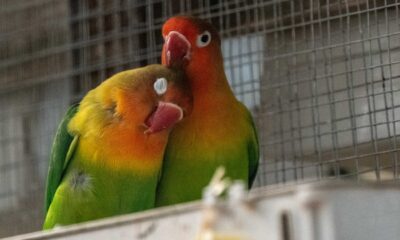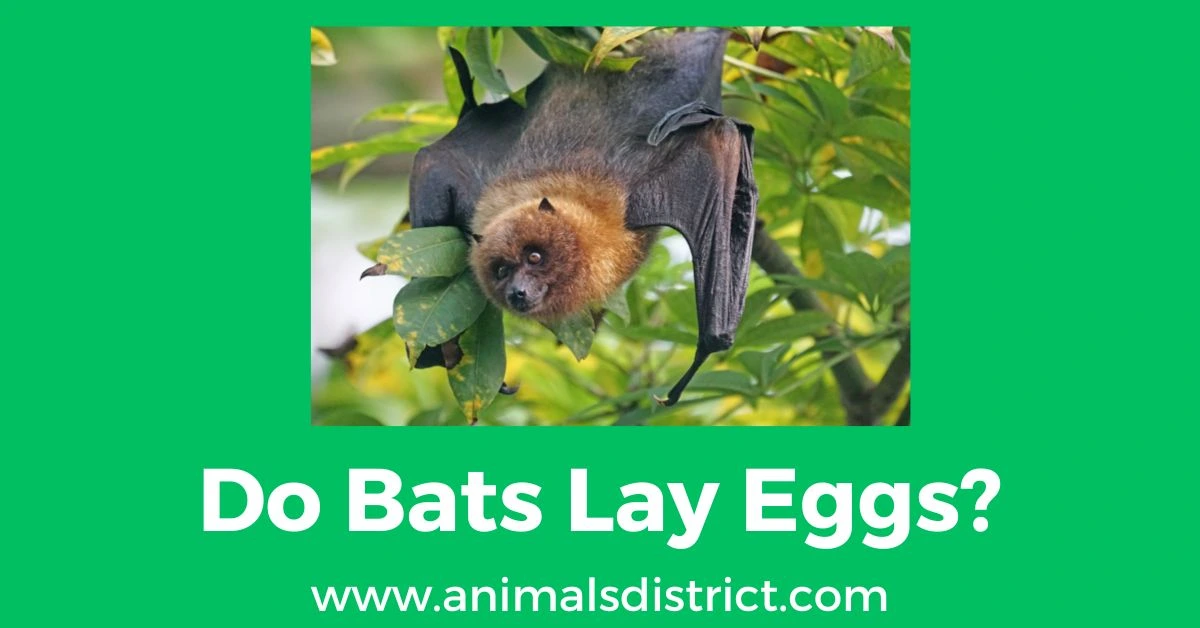Birds
Do Bats Have Tails? ALL You Need To Know (2023)

Last Updated on June 29, 2023 by israel olaniran
Bats, fascinating creatures of the night sky, have captured the curiosity of humans for centuries. These nocturnal mammals possess unique adaptations that allow them to navigate and hunt in darkness, but what about their tails? In this article, we will delve into the question: Do bats have tails?
Read: do birds have tongues?
Do Bats Have Tails?
Do bats have tails? While some bat species do possess tails, many others are tailless. The presence or absence of a tail in bats is determined by the species. Tailless bats have adapted alternative mechanisms, such as elongated thumbs or unique wing shapes, to compensate for the lack of a tail. Their flight capabilities remain impressive, showcasing the remarkable adaptations and diversity found within the bat family.
Read: do birds have ears?
| Bat Species | Tail Present | Tail Absent |
|---|---|---|
| Fruit Bats | Yes | |
| Flying Foxes | Yes | |
| Microbats | Yes | |
| Old World Leaf-nosed | Yes | |
| Horseshoe Bats | Yes | |
| Vesper Bats | Yes | |
| Tube-nosed Bats | Yes | |
| Bulldog Bats | Yes | |
| Nectar-feeding Bats | Yes | |
| False Vampire Bats | Yes | |
| Pallid Bats | Yes | |
| Whiskered Bats | Yes | |
| Sac-winged Bats | Yes | |
| Vampire Bats | Yes | |
| Tomb Bats | Yes | |
| Noctule Bats | Yes | |
| Free-tailed Bats | Yes | |
| Sheath-tailed Bats | Yes | |
| Ghost-faced Bats | Yes | |
| Wrinkle-faced Bats | Yes | |
| Disk-winged Bats | Yes |
Understanding Bats
Bats belong to the order Chiroptera and are the only mammals capable of sustained flight. They come in various shapes and sizes, with over 1,400 species identified worldwide. These remarkable creatures play vital roles in ecosystems, such as pollination and insect control.
Bat Anatomy: Bats have a distinctive anatomy. Their bodies are covered in fur, and they possess leathery wings formed by a thin membrane of skin stretched between elongated fingers. Their forelimbs are adapted for flight, while their hind limbs vary in structure based on their feeding and roosting habits.
Read: why do birds chirp at night?
🐾 Are you a dog owner who wants to ensure your dog gets the absolute best in terms of nutrition?
Common Bat Characteristics: Bats are often associated with certain characteristics such as echolocation, hibernation, and the ability to hang upside down. However, their tails have been a subject of curiosity among researchers and enthusiasts alike.
Different Bat Species: It’s important to note that the bat family is diverse, and not all species exhibit the same physical traits. Each bat species has unique features that enable them to thrive in their specific environments.

The Tail Mystery
Tails in Mammals: Tails are commonly found among mammals and serve various functions, including balance, communication, and locomotion. Many mammals rely on their tails for activities such as climbing, grasping objects, or swimming.
Bat Tails: Fact or Fiction? When it comes to bats, the presence or absence of tails can vary. While some bats do possess tails, they are relatively short compared to those found in other mammals. However, a significant number of bat species are tailless, which adds to the mystery surrounding these intriguing creatures.
Read: can birds see glass?
Bat Anatomy Explored
Bat Skeleton Structure: To better understand bat tails, it’s crucial to explore their skeletal structure. The skeleton of a bat is incredibly lightweight, consisting of thin and delicate bones. Their wing structure is primarily supported by elongated fingers, while the tailbone, known as the uropatagium, plays a role in stabilizing flight.
Bat Wings and Tail Bones: Bats utilize their wings to maneuver through the air, relying on flexible joints and strong muscles. The tail bones, although present, are relatively short and inconspicuous compared to the elongated fingers that support the wings.
Tailbone Variations in Bats: While most bats have tailbones, their length and visibility vary greatly among species. In some cases, the tailbone may be almost undetectable, leading to the misconception that bats are tailless.
Read: yellow and black birds in califonia
Tailless Bats
Examples of Tailless Bats: Certain bat species, such as the sac-winged bat or the vampire bat, are known for their apparent lack of tails. These bats have evolved without a prominent tail, giving them a distinct appearance compared to their tailed counterparts.
Tailless Bat Adaptations: The absence of a tail in certain bat species is compensated by other adaptations. Tailless bats often have elongated thumbs or unique wing shapes that enhance their flight capabilities. These adaptations allow them to maintain agility and maneuverability while flying without the aid of a tail.
Taillessness and Flight Efficiency: Contrary to common belief, the absence of a tail does not hinder a bat’s ability to fly efficiently. Tailless bats have adapted their flight mechanisms to compensate for the lack of a tail, showcasing their remarkable evolutionary abilities.
Final Thoughts On Do Bats Have Tails?
In conclusion, the presence of tails in bats is not universal. While some bat species do possess tails, many are tailless, exhibiting unique adaptations to compensate for their absence. The skeletal structure and anatomy of bats play a crucial role in their flight capabilities, with or without a tail. The world of bats continues to unravel its mysteries, captivating scientists and nature enthusiasts alike.
FAQs
Do all bats have tails?
No, not all bats have tails. Many bat species are tailless, while others possess relatively short tails.
What purpose does a bat’s tail serve?
In bats, the tail serves a minimal function compared to other mammals. It plays a minor role in stabilizing flight and maneuvering.
Are tailless bats more agile than bats with tails?
Tailless bats have evolved unique adaptations to enhance their flight capabilities, allowing them to be agile and maneuverable.
Bats rely on echolocation, a complex biological sonar system, to navigate and hunt, regardless of the presence or absence of a tail.
Can a bat’s tail grow back if it’s injured?
No, unlike some lizards or other animals, bat tails do not regenerate if injured or lost.
What bat has a tail?
Many bat species have tails, including fruit bats, microbats, old world leaf-nosed bats, horseshoe bats, vesper bats, tube-nosed bats, and more. Tails can vary in length and shape depending on the species.
Do some bats have long tails?
Yes, certain bat species have relatively long tails compared to others. Examples include the Indian flying fox, which has a long tail extending beyond its body, and the greater mouse-tailed bat, known for its exceptionally long tail that can exceed the length of its body.
Do fruit bats have tails?
Yes, fruit bats, also known as flying foxes, have tails. However, the length of their tails can vary among species. Some fruit bats have shorter tails, while others have longer tails.
How do bats fly without tail feathers?
Bats have evolved to fly without tail feathers. Instead of relying on feathers for flight like birds, bats have adapted elongated finger bones covered in a thin membrane of skin, which forms their wings. These wings provide the necessary lift and maneuverability for bats to fly effectively.
Do brown bats have tails?
Yes, brown bats, which belong to the Myotis genus, have tails. Their tails are relatively short compared to some other bat species, but they are still present.
Do bats have ears?
Yes, bats have ears. They possess highly developed ears that are essential for their echolocation abilities. Bats use echolocation to navigate and locate prey, emitting ultrasonic sounds and interpreting the echoes that bounce back to them.
Do bats have fur?
Yes, bats have fur. Like other mammals, bats are covered in fur, which helps regulate their body temperature and provides insulation.
Do bats have whiskers?
No, bats do not have true whiskers like some other mammals. Whiskers are specialized facial hairs used for tactile sensing, and bats rely more on their exceptional echolocation abilities for navigating their environment.
Do bats have fangs?
No, bats do not have fangs. While some bat species have prominent canine teeth, they are not elongated like fangs. Bats primarily feed on insects, fruits, nectar, or blood (in the case of vampire bats), and their teeth are adapted to their specific diets.
Do bats have hands?
Yes, bats have modified forelimbs that serve as wings, but these wings are essentially elongated hands. The bones in a bat’s wing correspond to the bones found in a human hand, with the digits elongated to support the wing membrane.
Bats with long tails:
Some bat species known for having relatively long tails include the greater mouse-tailed bat (Rhinopoma microphyllum), the Indian flying fox (Pteropus giganteus), the greater horseshoe bat (Rhinolophus ferrumequinum), and the greater false vampire bat (Megaderma lyra), among others.
Birds
Do Hawks Eat Rabbits? ALL You Need To Know (2023)

Last Updated on July 30, 2023 by israel olaniran
Hawks, the majestic birds of prey, have long captured the fascination of both nature enthusiasts and birdwatchers alike. With their keen eyesight and incredible hunting abilities, they play a vital role in the ecosystem as top-level predators. One question that often arises in discussions about hawks is, “Do hawks eat rabbits?” In this article, we will delve into the intriguing relationship between hawks and rabbits, exploring the dynamics of their interactions in the wild and the significance of their coexistence.
Read: do hawks eat snakes?
Do Hawks Eat Rabbits?
Yes, hawks do eat rabbits. Hawks are formidable birds of prey with keen hunting abilities, and rabbits are among their favored prey. Hawks rely on their sharp vision and aerial prowess to spot, pursue, and capture rabbits, making them an essential part of the predator-prey dynamics in the natural world.
The relationship between hawks and rabbits highlights the delicate balance and ecological significance of such interactions in maintaining healthy ecosystems.

Hawks: Characteristics and Habits
Hawks are raptors belonging to the family Accipitridae. These birds are renowned for their sharp vision, powerful talons, and hooked beaks that enable them to be highly efficient hunters. Hawks exhibit a wide range of sizes and appearances, from the small and agile Sharp-shinned Hawk to the majestic and formidable Red-tailed Hawk. Their hunting behavior is characterized by swift and precise movements as they target their prey from elevated vantage points.
Read: what animals eat hawks?
Rabbits: An Easy Prey
Rabbits, on the other hand, belong to the family Leporidae and are known for their rapid reproductive abilities. They are small herbivorous mammals that inhabit various habitats, from forests to grasslands. Rabbits reproduce quickly, and their population can grow exponentially under favorable conditions. However, they are also vulnerable to predation due to their relatively small size and lack of substantial defensive mechanisms.
Read: how much weight can a hawk carry?
Hawk and Rabbit Interaction in the Wild
The encounter between a hawk and a rabbit in the wild is a testament to the predator-prey relationship. Hawks are equipped with exceptional eyesight that allows them to spot potential prey from great distances. Once a hawk identifies a rabbit as a target, it employs various techniques to capture its meal. The element of surprise is crucial in a successful hunt, and hawks are known for their swift and stealthy approaches when diving towards their unsuspecting prey.
🐾 Are you a dog owner who wants to ensure your dog gets the absolute best in terms of nutrition?
Read: All you need to know about rabbit poop?
Impact of Hawks on Rabbit Population
As apex predators, hawks play a significant role in maintaining the balance of the ecosystem. By preying on rabbits and other small mammals, they help control the population of these species, preventing overpopulation and its subsequent effects on vegetation and other animals. While hawk predation may cause a decline in the rabbit population in certain regions, it ultimately benefits the overall health of the ecosystem.
Coexistence and Survival Strategies
Over time, rabbits have developed various survival strategies to cope with the constant threat of hawk predation. Their keen sense of hearing and speed enable them to detect the approach of hawks and other predators. In addition, rabbits often seek shelter in burrows or dense vegetation to evade capture. Despite being a potential food source for hawks, rabbits’ ability to reproduce rapidly and adapt to their environment helps maintain a healthy prey population for hawks and other predators.
Human Impact and Conservation Efforts
Human intervention can significantly affect the dynamics between hawks and rabbits. Habitat loss and environmental degradation may disrupt the natural balance, leading to population imbalances in both species. Conservation efforts that focus on preserving natural habitats and protecting endangered species are vital in maintaining the delicate ecological relationships between predators like hawks and their prey.
Understanding the Food Chain
The hawk-rabbit interaction highlights the concept of the food chain and trophic levels in an ecosystem. Hawks, as apex predators, occupy the highest trophic level, while rabbits are primary consumers at a lower trophic level. The interdependence of these levels ensures the stability and functioning of the entire ecosystem.
Fascinating Facts about Hawks and Rabbits
Before concluding, let’s explore some interesting trivia about hawks and rabbits. Did you know that some hawks are migratory, covering thousands of miles during their seasonal movements? On the other hand, rabbits are known for their remarkable agility, capable of reaching speeds of up to 35 miles per hour to escape predators.
Final Thoughts On Do Hawks Eat Rabbits?
In conclusion, the question “Do hawks eat rabbits?” reveals a captivating tale of predator-prey dynamics in the natural world. Hawks, with their prowess and precision, contribute to the ecological balance by controlling rabbit populations and other small mammals. At the same time, rabbits’ adaptability and reproductive abilities enable them to coexist with their aerial predators. Understanding and appreciating these complex relationships are crucial for promoting conservation efforts and safeguarding the delicate harmony of our ecosystems.
Are all hawks carnivorous?
While the majority of hawks are carnivorous and primarily feed on small mammals and birds, some hawks have adapted to consume a more varied diet, including insects and reptiles.
Do hawks only eat live prey?
Hawks are indeed carnivores and primarily hunt live prey. However, they may occasionally scavenge on carrion when live prey is scarce.
Can rabbits defend themselves from hawks?
Rabbits rely on their agility and evasive skills to avoid predation. While they can’t physically defend themselves against hawks, their speed and ability to take cover serve as their primary defense mechanisms.
How fast can a hawk swoop down to catch a rabbit?
Hawks are incredibly fast and can reach speeds of up to 120 miles per hour during their dives or swoops to catch prey
What is the lifespan of hawks and rabbits?
The lifespan of hawks and rabbits can vary depending on the species and their living conditions. Hawks generally live around 10 to 20 years, while rabbits in the wild have an average lifespan of about 1 to 2 years due to various predators and environmental factors.
Do eagles eat rabbits?
Yes, eagles are also birds of prey, and like hawks, they have a carnivorous diet that includes rabbits and other small mammals as part of their pr
What animal eats rabbits?
Several predators eat rabbits, including hawks, eagles, owls, foxes, coyotes, bobcats, and even larger snakes and some species of weasels.
Can snakes eat rabbits?
yes, some larger snake species, such as certain constrictors, can consume rabbits as part of their diet.
How do hawks kill rabbits?
Hawks use their sharp talons to grasp and immobilize their prey, including rabbits. They may deliver a swift strike from the air or pounce on rabbits from elevated perches.
Do hawks eat snakes?
Yes, some hawk species do eat snakes. Snakes are another prey item for certain types of hawks.
Do hawks eat birds?
Yes, birds are a common part of a hawk’s diet. Hawks are skilled hunters and can catch other birds during flight.
Do hawks eat grasshoppers?
While hawks primarily prey on small mammals and birds, they may also consume insects like grasshoppers occasionally, especially during times of food scarcity.
Do hawks eat squirrels?
Yes, squirrels are a part of a hawk’s diet, and some hawk species are adept at catching squirrels in trees and on the ground.
Do hawks eat small dogs?
While it is rare, some large hawk species could potentially target small dogs as prey, though it is not a common occurrence. Small dogs are generally not a primary target for hawks.
-
Domestic Animals2 years ago
Why Do Dogs Look Away When You Eat
-
Domestic Animals6 months ago
Small But Smart: 10 Most Intelligent Small Dog Breeds
-
Wild Animals2 years ago
What Does Snake Poop Look Like? PICTURES & VIDEOS
-
Pet News6 months ago
Trending Now: Woman Raised A Panther Thinking It Was A Cat.
-
Domestic Animals8 months ago
Why Does My Cat Sleep On My Feet? Best Reasons
-
Insects7 months ago
Australian Stick Bug: ALL You Need To Know.
-
Domestic Animals1 year ago
Can Guinea Pigs Eat Oranges? ALL You Need To Know!
-
Domestic Animals2 years ago
Can Guinea Pigs Eat Pears? All You Need To Know (2023)





















